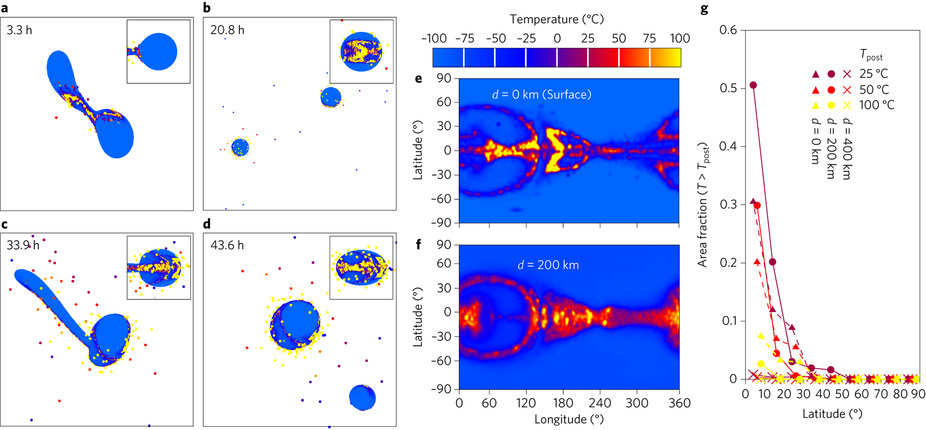カロンを形成した巨大衝突によってできた冥王星の暗い赤道領域
The Charon-forming giant impact as a source of Pluto’s dark equatorial regions
2017年1月30日 Nature Astronomy 1 : 31 doi: 10.1038/s41550-016-0031

冥王星に見られる大きな特徴は、その表面の物質や色が地域ごとに異なるという、複雑な多様性である。その中でも最も顕著な特徴は、赤道域に広がる赤褐色の物質―おそらく有機物―であろう。赤道域の赤褐色有機物は、水氷を主成分とする氷地殻に含まれて存在しているが、この有機物を作り出した原因についてはよくわかっていない。本論文では、冥王星のこの赤褐色の領域が、冥王星の巨大衛星カロンを形成した巨大天体衝突によって形成したものであることを提案する。カロンを形成する巨大天体衝突では、冥王星の赤道付近は激しく加熱され、赤道に沿って細長く伸びた液体水の海が形成し、その液体中での化学反応によって赤褐色の有機物が合成されうる。本研究では、まず室内実験を行い、50℃以上の加熱が長期間(数か月以上)続くことにより、原始冥王星に含まれていたホルムアルデヒドなどの単純な有機化合物が重合して、赤褐色物質の有機物が生成することを示した。さらに、流体力学に基づく衝突数値シミュレーションにより、冥王星の三分の一の質量をもつ天体が、内部の温度が150~200ケルビンの原始冥王星と衝突することで、カロンと同程度の大きさの衛星と冥王星赤道域に50℃以上の加熱領域の両方を同時につくり出すことができることを示した。また本研究では、カロンを作った衝突よりも高速での衝突が起きた場合、全球的あるいは半球的に表面が赤褐色化することを示した。このような全球的に赤褐色の天体はカイパーベルトにも複数存在しており、カイパーベルト天体の色の多様性が、初期太陽系において頻発していた巨大天体衝突によって生み出された可能性を示唆している。

